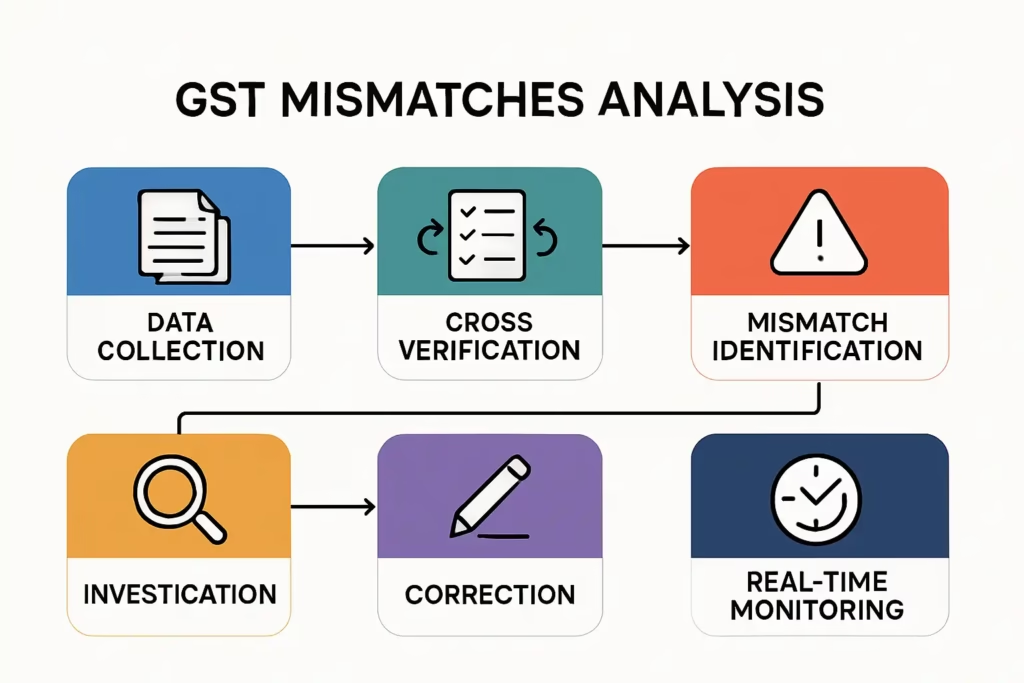Goods and Services Tax (GST) compliance is vital for businesses in India to ensure smooth operations and avoid penalties. However, mismatches in GST data can create significant challenges during compliance checks, audits, and input tax credit claims. This blog will provide a step-by-step guide on the analysis of GST mismatches and practical ways to resolve them efficiently using advanced GST data analysis and GST tools.
What is Analysis of GST and Why is it Crucial?
Analysis of GST involves a detailed study and cross-verification of GST returns filed by a business with the data available with tax authorities. It helps identify inconsistencies such as invoice mismatches, missing transactions, or errors in reporting that lead to compliance issues. In India, with evolving GST regulations, robust GST data analysis is essential to maintain compliance, optimize tax credits, and streamline audit processes.
Common Causes of GST Mismatches in India
- Incorrect GSTIN or invoice details in returns (GSTR-1 vs. GSTR-2A mismatches)
- Timing differences in invoice reporting by suppliers and recipients
- Data entry errors during return filing
- Omission of credit/debit notes or amendments
- Discrepancies in outward and inward supplies data
- Non-reporting or delayed filing by suppliers
The varying impact of GST regulations across industries often leads to filing discrepancies if not carefully analyzed. For a clear overview of the GST framework, rates, and compliance updates affecting these mismatches, refer to our detailed guide on GST in India 2025: Structure, Rates, Compliance & Analysis.
Step-by-Step Guide to GST Mismatches and Resolution

Step 1: Collect and Consolidate GST Data
Gather all inward and outward supply data, including GSTR-1, GSTR-2A/2B, and related financial documents. A GST tool with powerful reconciliation features simplifies this task by automating data aggregation.
Step 2: Cross-Verify GST Returns with Available Data
Compare details in the GSTR-1 (supplier returns) against GSTR-2A/2B (recipient auto-populated returns). Look for mismatched invoice numbers, taxable values, and tax amounts.
Step 3: Identify Mismatched or Missing Transactions
Pinpoint invoices or entries that do not reconcile, including discrepancies in invoice amounts, missing invoices in supplier or recipient returns, and incorrect tax classifications.
Step 4: Investigate the Root Cause of Mismatches
Conduct a study of GST filings, communication with vendors/customers, and internal accounting records to find why mismatches occurred—whether due to delayed filing, errors, or fraud.
Step 5: Rectify Errors in Amendments or Next Return Filings
Prepare amendments or revised returns to correct inaccurate GST filings. Ensure proper documentation for all changes to support compliance audits.
Step 6: Implement Continuous Monitoring Using GST Tools
Leverage automated GST tool solutions for real-time GST data analysis to detect mismatches proactively. Continuous monitoring reduces compliance risk and improves input tax credit accuracy.
Tips:
Continuous monitoring using advanced GST tools allows businesses to proactively identify mismatches. Our Best GST Software List India blog outlines several effective GST tools designed for real-time GST data analysis, automating mismatch alerts and streamlining compliance efforts.
Frequently Asked Questions (FAQ)
Q1: What is a GST mismatch?
A GST mismatch occurs when the details in your GST returns don’t match those filed by your suppliers or customers, often due to errors or timing differences. Resolving these mismatches is key to staying compliant.
Q2: How does analyzing the GST help to improve compliance?
It detects discrepancies early, encourages accurate reporting, and helps claim correct input tax credits, ensuring better compliance and avoiding penalties.
Q3: What is the role of a GST tool in mismatch analysis?
GST tools automate data collection, comparison, and reporting, making the analysis of GST efficient and actionable, saving time and reducing manual errors.
Q4: Can mismatch resolution affect input tax credit claims?
Yes. Correcting mismatches ensures that input tax credits claimed are valid and supported by genuine transactions, minimizing rejections during audits.
Q5: Is continuous GST monitoring necessary for businesses?
Absolutely. Proactive GST evaluation with the latest software helps maintain compliance and financial accuracy.
Conclusion
A thorough analysis of GST mismatches is essential for businesses to maintain GST compliance in India. By following these steps and leveraging advanced GST tools for automated GST data analysis, you can efficiently resolve mismatches, optimize tax credits, and avoid costly penalties.
Investing in a reliable GST tool that supports continuous analysis of GST will empower your business with accuracy and confidence. Start today to stay ahead in your GST compliance journey!
For expert GST data analysis and unmatched compliance support, explore our advanced GST tool designed to simplify your GST challenges and drive business success.



